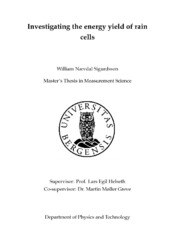| dc.contributor.author | Sigurdsson, William Nævdal | |
| dc.date.accessioned | 2018-12-10T16:27:47Z | |
| dc.date.available | 2018-12-10T16:27:47Z | |
| dc.date.issued | 2018-12-08 | |
| dc.date.submitted | 2018-12-07T23:00:02Z | |
| dc.identifier.uri | https://hdl.handle.net/1956/18751 | |
| dc.description.abstract | Harvesting energy from rain has been done indirectly for hundreds of years by building dams or reservoirs. Recently, research has been made into gathering energy from individual raindrops. One of the discovered methods make use of the triboelectric effect taking place when rain drops land on a hydrophobic polymer. Electrical charge is induced in interdigitated electrodes beneath the polymer, and a voltage is induced between them. This thesis uses a simple model to describe the electrical behaviour of such a rain cell, and evaluates the energy harvesting potential it represents. Power measurements for different resistive loads are taken to determine the effective capacitance of the rain cell. A model for the charging and discharging of a storage capacitor through a full wave rectifier is developed and compared with experiment. The power and charge delivered by a raindrop are derived and a model relating the energy storage to the rain intensity is created and used to evaluate the limits of the rain cell. | en_US |
| dc.language.iso | eng | eng |
| dc.publisher | The University of Bergen | en_US |
| dc.subject | Rain cell | eng |
| dc.subject | triboelectric effect | eng |
| dc.subject | Fornybar energi | nob |
| dc.title | Investigating the energy yield of rain cells | en_US |
| dc.type | Master thesis | |
| dc.date.updated | 2018-12-07T23:00:02Z | |
| dc.rights.holder | Copyright the Author. All rights reserved | en_US |
| dc.description.degree | Masteroppgave i fysikk | en_US |
| dc.description.localcode | MAMN-PHYS | |
| dc.description.localcode | PHYS399 | |
| dc.subject.realfagstermer | https://data.ub.uio.no/realfagstermer/c012789 | |
| dc.subject.nus | 752199 | eng |
| fs.subjectcode | PHYS399 | |
| fs.unitcode | 12-24-0 | |
